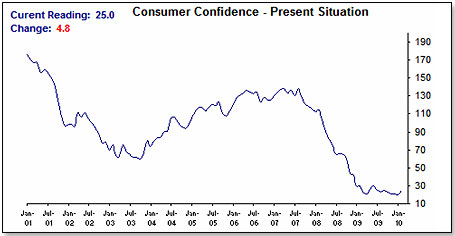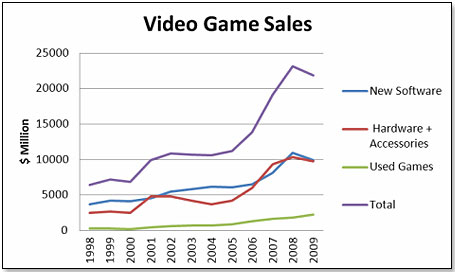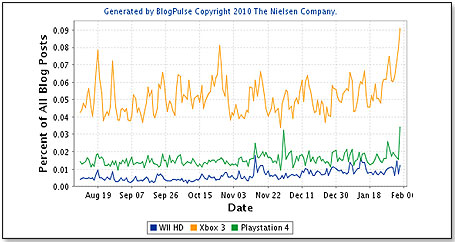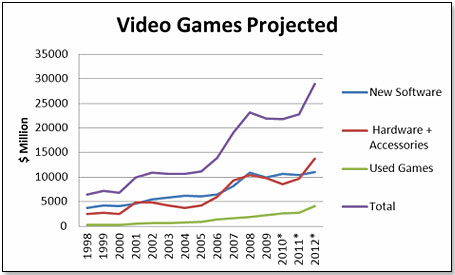 |

Tools:








Video Game Sales Will Stagnate Before SurgingOnLive and Next-Gen Hardware Put Gamers in Waiting
| “Unless these rumors are convincingly repudiated, we can look forward to a repeat of the 2001 to 2006 trend — declining new hardware and stagnating new software sales.” |
After several years of steep sales increases, new video game software and hardware suffered a decline in 2009. This is generally blamed on economic factors that began to turn negative in late 2007 and that, still today, depress purchase motivation for both categories.
The Consumer Confidence Index tells the story:

Data Courtesy of The Conference Board Copyright 2010 Market Harmonics
However, in the specific case of video games there might be another explanation.
When we look back to 2001, we notice that this was the last year in which the new hardware sector grew before it began a sharp decline that lasted until 2005 when sales began to sharply accelerate. The curve for new software was distinctly different — there was really no decline but there was stagnation between 1998 and 2005, followed by an accelerating upward trend. Used games continued to grow steadily throughout. The graph below demonstrates this:

Data Source: NPD for new Software and Hardware/Accessories
So, what happened between 2001 and 2006?
In 2001, it became evident to video game aficionados that a new generation of hardware was being developed. The consequence was that they began to hold back buying consoles in anticipation of the day when the new versions would become available. They then promptly returned to the stores when Microsoft’s Xbox 360 was released on November 22, 2005, and the trend accelerated with the launch of the Sony PS3 and the Nintendo Wii in November 2006.
Interestingly, used games continued to grow throughout but had a sharp uptick in 2006 when the games purchased to run the new consoles began to enter the used game marketplace.
Fast forward to 2009, when rumors began to swirl about ongoing new console developments and forthcoming releases of hardware replacing the current generation of machines. Specifically, the dates that begun to be bandied about were and continue to be November 2011 for the Wii HD and Fall 2012 for both PS4 and the Xbox 3 [also referred to as Xbox 720]. The chart below demonstrates the growing intensity in the blog sphere, which is generally considered a reflection of consumer interest in a given subject:

Just as the current generation of hardware represented a sea change in technical terms if compared to the PS2, the Xbox and the GameCube, so are the next-generation machines expected to make a quantum leap in terms of graphics, downloads, memory capacity and overall technical dimensions.
Whether these expectations are founded in reality is not material. What matters is the perception held by consumers. Unless these rumors are convincingly repudiated, we can look forward to a repeat of the 2001 to 2006 trend — declining new hardware and stagnating new software sales. Used games should continue to do well as was demonstrated during the 2001 to 2006 cycle, but should really start taking off about one year after the release of the new consoles.
This is how I project the above graph forward:

While all the data shown in this article is focused on the United States, it is very probable that the largest market for video games, Europe, will see similar trends.
There are likely to be the following consequences if these materialize:
• The major retailers — Wal-Mart, GameStop, Toys “R” Us and the Game Group in Europe — will see stagnation or even declines in their sales of the category. Of all these, GameStop is in the best position on account of its near-monopoly in high-margin used games.
• The retailers are likely to engage in price fights to increase market shares and will, as a consequence, face margin erosion.
• The major publishers — Activision, Electronic Arts, TakeTwo, THQ and Ubisoft — will likely initiate major economic measures to safeguard their bottom line in the face of stagnating or even declining revenue streams.
None of these projections foresees a fundamental change in the way games are accessed. One possible candidate is the OnLive technology first unveiled at CES in 2009. Since then, OnLive has gone into Beta testing and it is apparently going well.
The basis of the technology is that games are no longer downloaded but rather are accessed “in the cloud” via PC, Mac or the TV. Partners to the developer are all major publishers other than Activision and THQ.
OnLive now has three data centers with coverage as shown below:

Any gamer living within the areas covered by any of the three circles can apply to participate in the Beta testing program. If you do, and are willing to share your opinion, please email your findings.
There is little doubt in my mind that OnLive could be a game changer and would severely affect video game retailers, hardware manufacturers, used games sellers, and pirates alike. There is basically only one major reservation, assuming that the Beta test turns out to be successful: Will the OnLive DataCenters be able to cope if the number of subscribers accessing the centers simultaneously goes into the millions?
 Writer's Bio: Writer's Bio: Lutz Muller is a Swiss who has lived on five continents. In the United States, he was the CEO for four manufacturing companies, including two in the toy industry. Since 2002, he has provided competitive intelligence on the toy and video game market to manufacturers and financial institutions coast-to-coast. He gets his information from his retailer panel, from big-box buyers and his many friends in the industry. If anything happens, he is usually the first to know. Read more on his website at www.klosterstrading.com. Read more articles by this author
THIS BANNER IS AN AD:

• • • • • • • • • • • • • • | • • • • • • • • • • • • • • |
Back to TDmonthly's front page
|  |
Advertise on TDmonthly

|

